Financial Management: Importance, Analysis, and Performance Report
VerifiedAdded on 2022/12/26
|13
|2592
|34
Report
AI Summary
This report provides a comprehensive overview of financial management, emphasizing its significance in business operations. It defines financial management as the planning, organizing, and controlling of financial activities to optimize fund utilization. The report delves into the main financial statements, including the income statement, balance sheet, cash flow statement, and statement of changes in equity, explaining their roles in assessing a company's financial position. Ratio analysis is then explored as a key tool for evaluating performance, with examples of profitability, liquidity, and efficiency ratios. The report includes an income statement and balance sheet, along with a detailed analysis of the company's financial position using ratio analysis. Finally, it discusses strategies businesses can employ to enhance financial performance, such as budgetary control, optimized liquidity, and improved asset turnover. The report concludes by highlighting the importance of proactive financial management for sustained business success.

Applied Business Finance
(Importance of financial management)
(Importance of financial management)
Paraphrase This Document
Need a fresh take? Get an instant paraphrase of this document with our AI Paraphraser
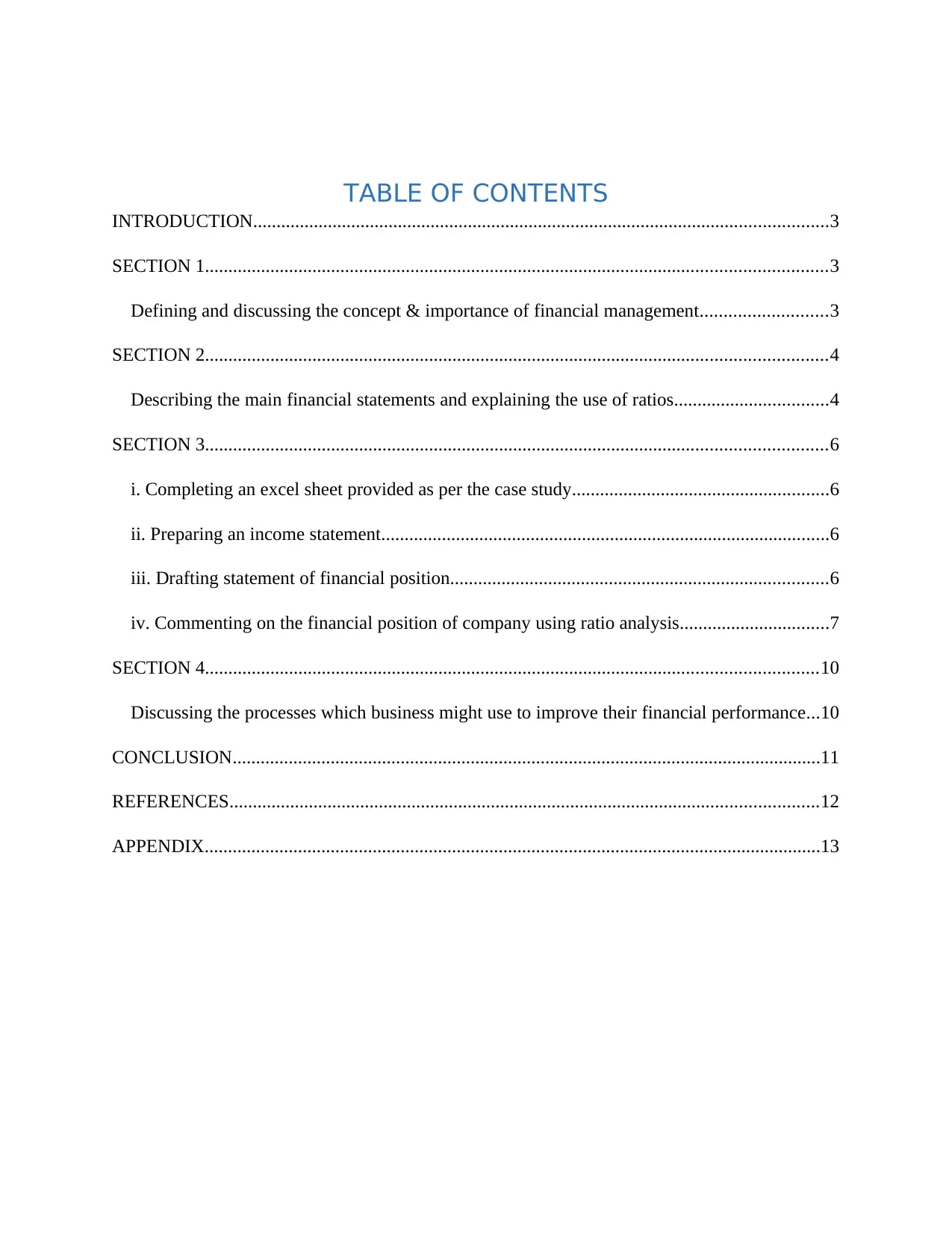
TABLE OF CONTENTS
INTRODUCTION...........................................................................................................................3
SECTION 1.....................................................................................................................................3
Defining and discussing the concept & importance of financial management...........................3
SECTION 2.....................................................................................................................................4
Describing the main financial statements and explaining the use of ratios.................................4
SECTION 3.....................................................................................................................................6
i. Completing an excel sheet provided as per the case study.......................................................6
ii. Preparing an income statement................................................................................................6
iii. Drafting statement of financial position.................................................................................6
iv. Commenting on the financial position of company using ratio analysis................................7
SECTION 4...................................................................................................................................10
Discussing the processes which business might use to improve their financial performance...10
CONCLUSION..............................................................................................................................11
REFERENCES..............................................................................................................................12
APPENDIX....................................................................................................................................13
INTRODUCTION...........................................................................................................................3
SECTION 1.....................................................................................................................................3
Defining and discussing the concept & importance of financial management...........................3
SECTION 2.....................................................................................................................................4
Describing the main financial statements and explaining the use of ratios.................................4
SECTION 3.....................................................................................................................................6
i. Completing an excel sheet provided as per the case study.......................................................6
ii. Preparing an income statement................................................................................................6
iii. Drafting statement of financial position.................................................................................6
iv. Commenting on the financial position of company using ratio analysis................................7
SECTION 4...................................................................................................................................10
Discussing the processes which business might use to improve their financial performance...10
CONCLUSION..............................................................................................................................11
REFERENCES..............................................................................................................................12
APPENDIX....................................................................................................................................13
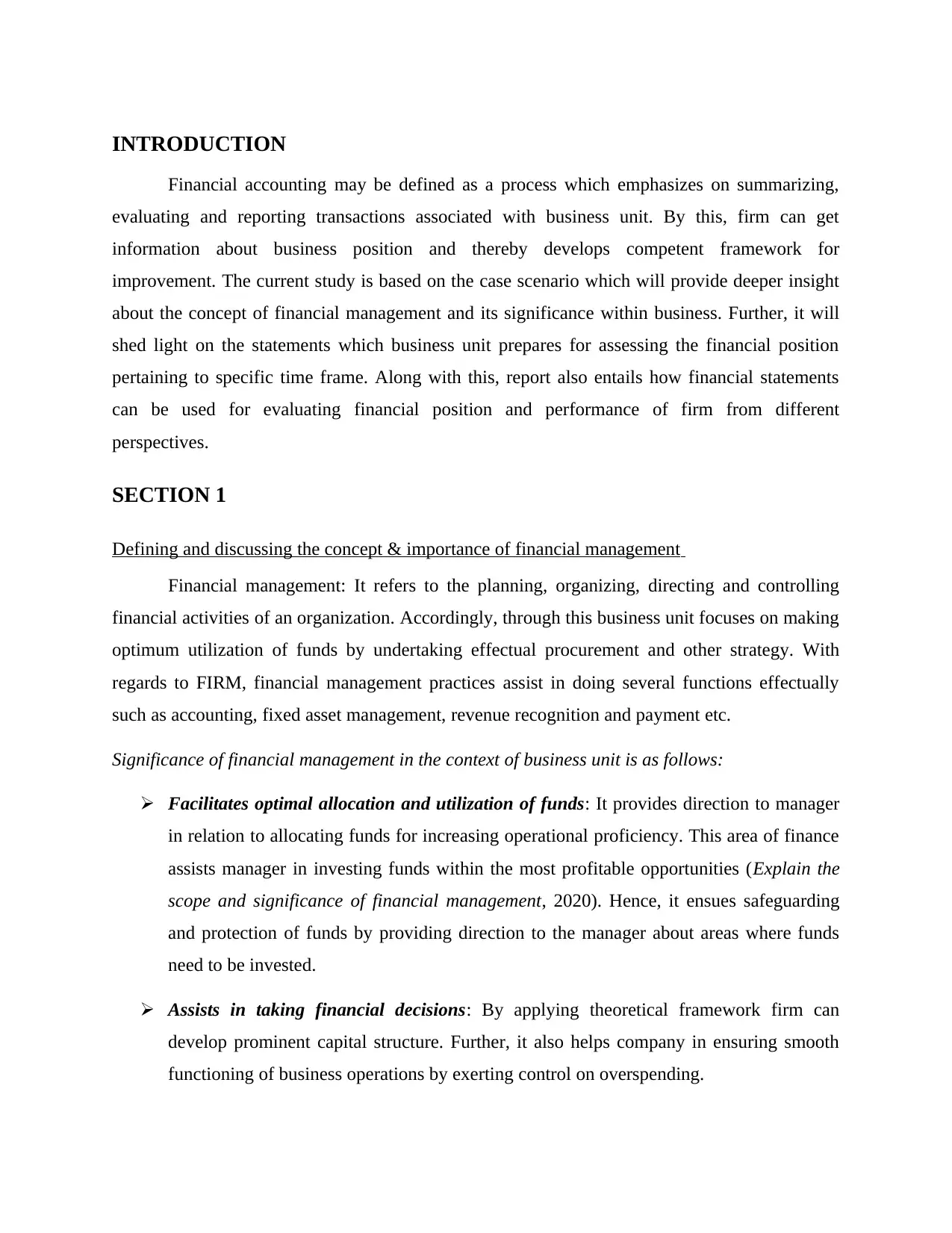
INTRODUCTION
Financial accounting may be defined as a process which emphasizes on summarizing,
evaluating and reporting transactions associated with business unit. By this, firm can get
information about business position and thereby develops competent framework for
improvement. The current study is based on the case scenario which will provide deeper insight
about the concept of financial management and its significance within business. Further, it will
shed light on the statements which business unit prepares for assessing the financial position
pertaining to specific time frame. Along with this, report also entails how financial statements
can be used for evaluating financial position and performance of firm from different
perspectives.
SECTION 1
Defining and discussing the concept & importance of financial management
Financial management: It refers to the planning, organizing, directing and controlling
financial activities of an organization. Accordingly, through this business unit focuses on making
optimum utilization of funds by undertaking effectual procurement and other strategy. With
regards to FIRM, financial management practices assist in doing several functions effectually
such as accounting, fixed asset management, revenue recognition and payment etc.
Significance of financial management in the context of business unit is as follows:
Facilitates optimal allocation and utilization of funds: It provides direction to manager
in relation to allocating funds for increasing operational proficiency. This area of finance
assists manager in investing funds within the most profitable opportunities (Explain the
scope and significance of financial management, 2020). Hence, it ensues safeguarding
and protection of funds by providing direction to the manager about areas where funds
need to be invested.
Assists in taking financial decisions: By applying theoretical framework firm can
develop prominent capital structure. Further, it also helps company in ensuring smooth
functioning of business operations by exerting control on overspending.
Financial accounting may be defined as a process which emphasizes on summarizing,
evaluating and reporting transactions associated with business unit. By this, firm can get
information about business position and thereby develops competent framework for
improvement. The current study is based on the case scenario which will provide deeper insight
about the concept of financial management and its significance within business. Further, it will
shed light on the statements which business unit prepares for assessing the financial position
pertaining to specific time frame. Along with this, report also entails how financial statements
can be used for evaluating financial position and performance of firm from different
perspectives.
SECTION 1
Defining and discussing the concept & importance of financial management
Financial management: It refers to the planning, organizing, directing and controlling
financial activities of an organization. Accordingly, through this business unit focuses on making
optimum utilization of funds by undertaking effectual procurement and other strategy. With
regards to FIRM, financial management practices assist in doing several functions effectually
such as accounting, fixed asset management, revenue recognition and payment etc.
Significance of financial management in the context of business unit is as follows:
Facilitates optimal allocation and utilization of funds: It provides direction to manager
in relation to allocating funds for increasing operational proficiency. This area of finance
assists manager in investing funds within the most profitable opportunities (Explain the
scope and significance of financial management, 2020). Hence, it ensues safeguarding
and protection of funds by providing direction to the manager about areas where funds
need to be invested.
Assists in taking financial decisions: By applying theoretical framework firm can
develop prominent capital structure. Further, it also helps company in ensuring smooth
functioning of business operations by exerting control on overspending.
⊘ This is a preview!⊘
Do you want full access?
Subscribe today to unlock all pages.

Trusted by 1+ million students worldwide
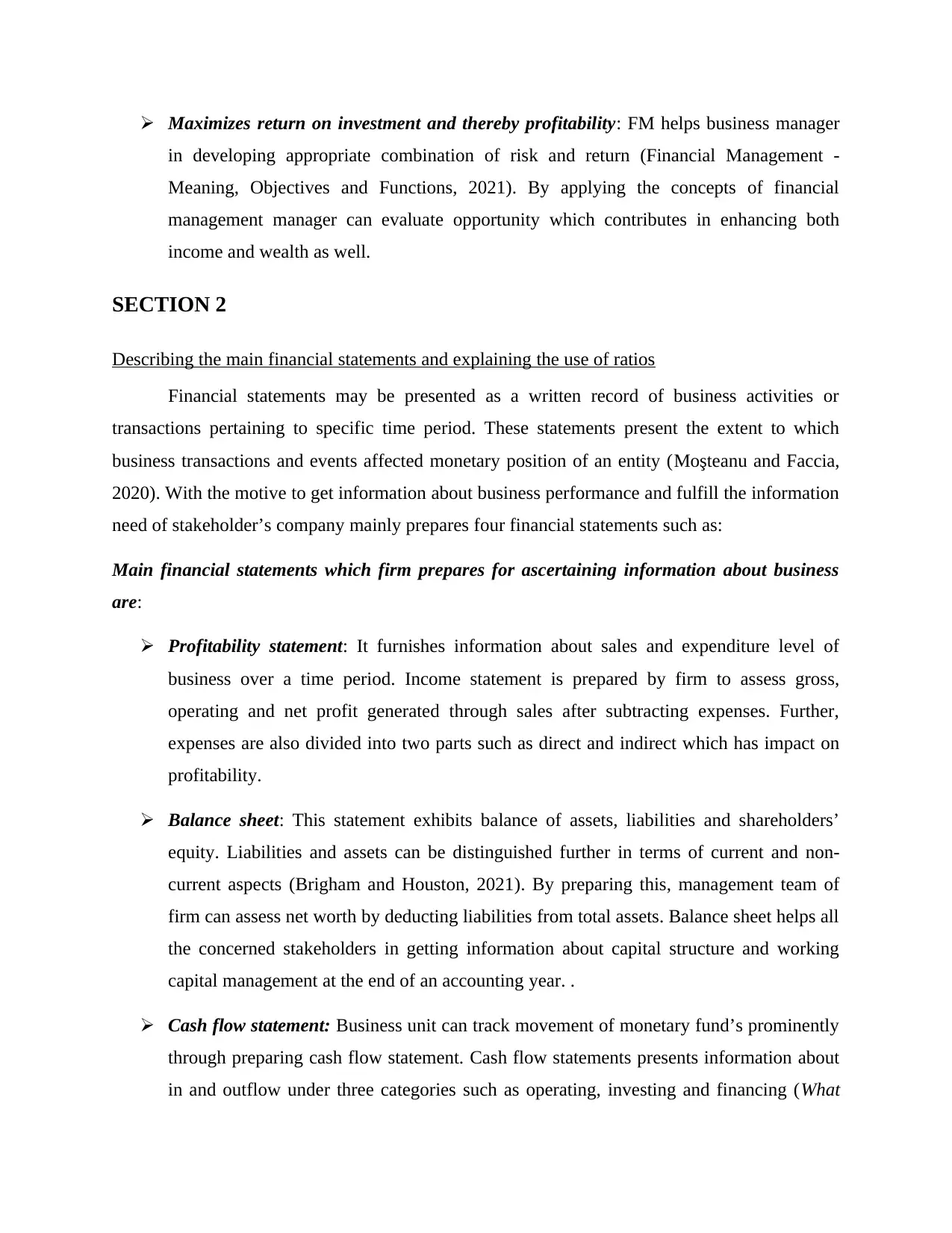
Maximizes return on investment and thereby profitability: FM helps business manager
in developing appropriate combination of risk and return (Financial Management -
Meaning, Objectives and Functions, 2021). By applying the concepts of financial
management manager can evaluate opportunity which contributes in enhancing both
income and wealth as well.
SECTION 2
Describing the main financial statements and explaining the use of ratios
Financial statements may be presented as a written record of business activities or
transactions pertaining to specific time period. These statements present the extent to which
business transactions and events affected monetary position of an entity (Moşteanu and Faccia,
2020). With the motive to get information about business performance and fulfill the information
need of stakeholder’s company mainly prepares four financial statements such as:
Main financial statements which firm prepares for ascertaining information about business
are:
Profitability statement: It furnishes information about sales and expenditure level of
business over a time period. Income statement is prepared by firm to assess gross,
operating and net profit generated through sales after subtracting expenses. Further,
expenses are also divided into two parts such as direct and indirect which has impact on
profitability.
Balance sheet: This statement exhibits balance of assets, liabilities and shareholders’
equity. Liabilities and assets can be distinguished further in terms of current and non-
current aspects (Brigham and Houston, 2021). By preparing this, management team of
firm can assess net worth by deducting liabilities from total assets. Balance sheet helps all
the concerned stakeholders in getting information about capital structure and working
capital management at the end of an accounting year. .
Cash flow statement: Business unit can track movement of monetary fund’s prominently
through preparing cash flow statement. Cash flow statements presents information about
in and outflow under three categories such as operating, investing and financing (What
in developing appropriate combination of risk and return (Financial Management -
Meaning, Objectives and Functions, 2021). By applying the concepts of financial
management manager can evaluate opportunity which contributes in enhancing both
income and wealth as well.
SECTION 2
Describing the main financial statements and explaining the use of ratios
Financial statements may be presented as a written record of business activities or
transactions pertaining to specific time period. These statements present the extent to which
business transactions and events affected monetary position of an entity (Moşteanu and Faccia,
2020). With the motive to get information about business performance and fulfill the information
need of stakeholder’s company mainly prepares four financial statements such as:
Main financial statements which firm prepares for ascertaining information about business
are:
Profitability statement: It furnishes information about sales and expenditure level of
business over a time period. Income statement is prepared by firm to assess gross,
operating and net profit generated through sales after subtracting expenses. Further,
expenses are also divided into two parts such as direct and indirect which has impact on
profitability.
Balance sheet: This statement exhibits balance of assets, liabilities and shareholders’
equity. Liabilities and assets can be distinguished further in terms of current and non-
current aspects (Brigham and Houston, 2021). By preparing this, management team of
firm can assess net worth by deducting liabilities from total assets. Balance sheet helps all
the concerned stakeholders in getting information about capital structure and working
capital management at the end of an accounting year. .
Cash flow statement: Business unit can track movement of monetary fund’s prominently
through preparing cash flow statement. Cash flow statements presents information about
in and outflow under three categories such as operating, investing and financing (What
Paraphrase This Document
Need a fresh take? Get an instant paraphrase of this document with our AI Paraphraser
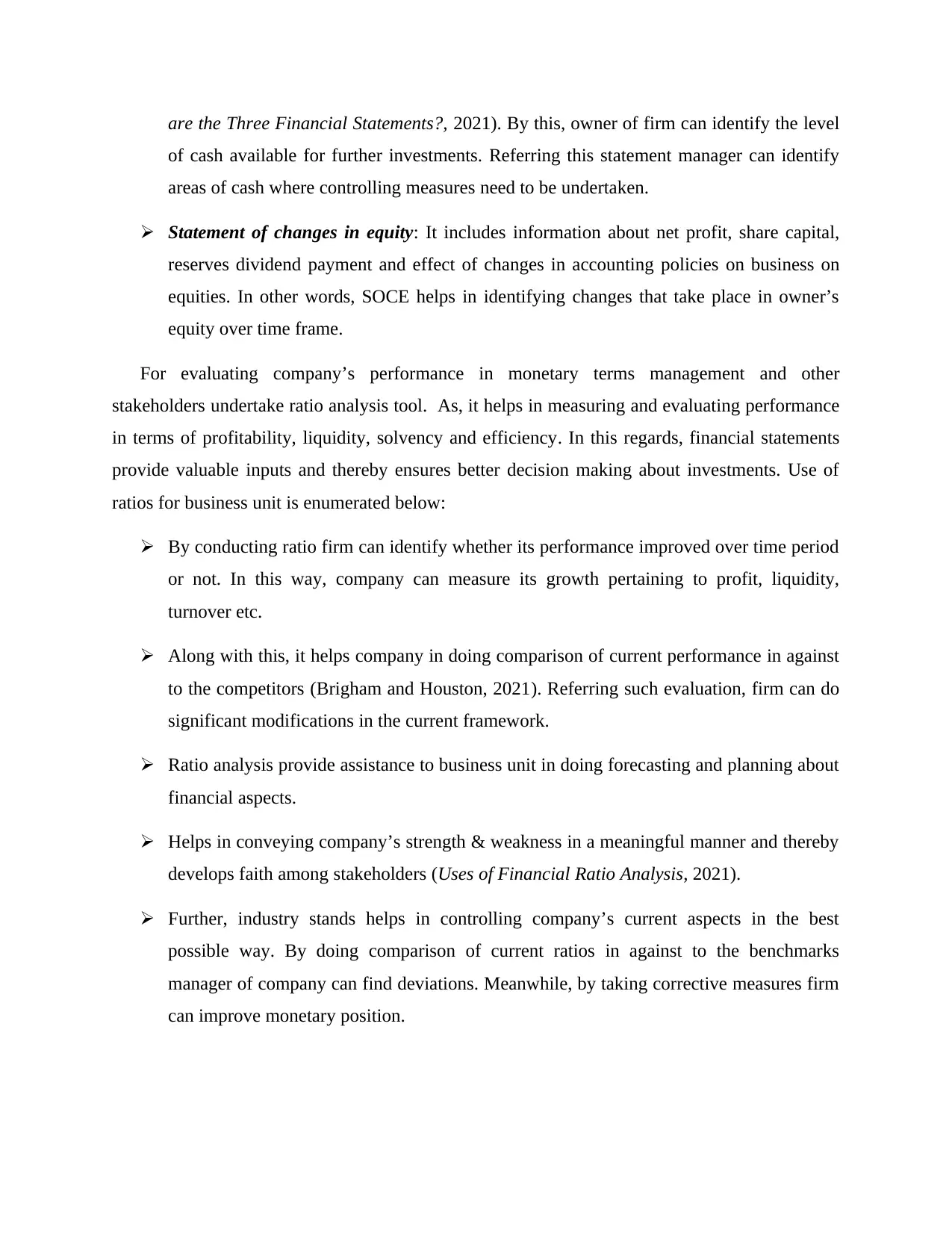
are the Three Financial Statements?, 2021). By this, owner of firm can identify the level
of cash available for further investments. Referring this statement manager can identify
areas of cash where controlling measures need to be undertaken.
Statement of changes in equity: It includes information about net profit, share capital,
reserves dividend payment and effect of changes in accounting policies on business on
equities. In other words, SOCE helps in identifying changes that take place in owner’s
equity over time frame.
For evaluating company’s performance in monetary terms management and other
stakeholders undertake ratio analysis tool. As, it helps in measuring and evaluating performance
in terms of profitability, liquidity, solvency and efficiency. In this regards, financial statements
provide valuable inputs and thereby ensures better decision making about investments. Use of
ratios for business unit is enumerated below:
By conducting ratio firm can identify whether its performance improved over time period
or not. In this way, company can measure its growth pertaining to profit, liquidity,
turnover etc.
Along with this, it helps company in doing comparison of current performance in against
to the competitors (Brigham and Houston, 2021). Referring such evaluation, firm can do
significant modifications in the current framework.
Ratio analysis provide assistance to business unit in doing forecasting and planning about
financial aspects.
Helps in conveying company’s strength & weakness in a meaningful manner and thereby
develops faith among stakeholders (Uses of Financial Ratio Analysis, 2021).
Further, industry stands helps in controlling company’s current aspects in the best
possible way. By doing comparison of current ratios in against to the benchmarks
manager of company can find deviations. Meanwhile, by taking corrective measures firm
can improve monetary position.
of cash available for further investments. Referring this statement manager can identify
areas of cash where controlling measures need to be undertaken.
Statement of changes in equity: It includes information about net profit, share capital,
reserves dividend payment and effect of changes in accounting policies on business on
equities. In other words, SOCE helps in identifying changes that take place in owner’s
equity over time frame.
For evaluating company’s performance in monetary terms management and other
stakeholders undertake ratio analysis tool. As, it helps in measuring and evaluating performance
in terms of profitability, liquidity, solvency and efficiency. In this regards, financial statements
provide valuable inputs and thereby ensures better decision making about investments. Use of
ratios for business unit is enumerated below:
By conducting ratio firm can identify whether its performance improved over time period
or not. In this way, company can measure its growth pertaining to profit, liquidity,
turnover etc.
Along with this, it helps company in doing comparison of current performance in against
to the competitors (Brigham and Houston, 2021). Referring such evaluation, firm can do
significant modifications in the current framework.
Ratio analysis provide assistance to business unit in doing forecasting and planning about
financial aspects.
Helps in conveying company’s strength & weakness in a meaningful manner and thereby
develops faith among stakeholders (Uses of Financial Ratio Analysis, 2021).
Further, industry stands helps in controlling company’s current aspects in the best
possible way. By doing comparison of current ratios in against to the benchmarks
manager of company can find deviations. Meanwhile, by taking corrective measures firm
can improve monetary position.
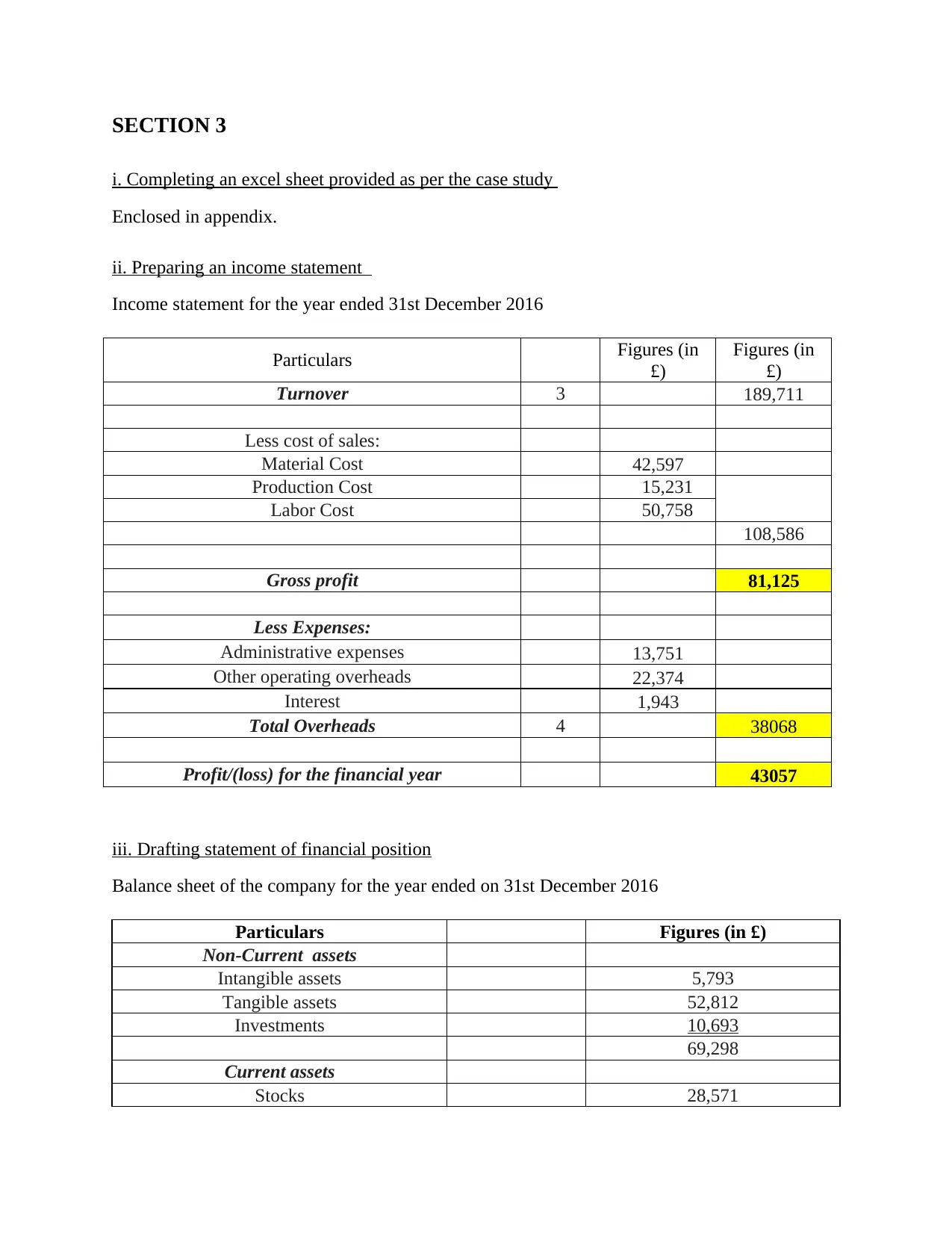
SECTION 3
i. Completing an excel sheet provided as per the case study
Enclosed in appendix.
ii. Preparing an income statement
Income statement for the year ended 31st December 2016
Particulars Figures (in
£)
Figures (in
£)
Turnover 3 189,711
Less cost of sales:
Material Cost 42,597
Production Cost 15,231
Labor Cost 50,758
108,586
Gross profit 81,125
Less Expenses:
Administrative expenses 13,751
Other operating overheads 22,374
Interest 1,943
Total Overheads 4 38068
Profit/(loss) for the financial year 43057
iii. Drafting statement of financial position
Balance sheet of the company for the year ended on 31st December 2016
Particulars Figures (in £)
Non-Current assets
Intangible assets 5,793
Tangible assets 52,812
Investments 10,693
69,298
Current assets
Stocks 28,571
i. Completing an excel sheet provided as per the case study
Enclosed in appendix.
ii. Preparing an income statement
Income statement for the year ended 31st December 2016
Particulars Figures (in
£)
Figures (in
£)
Turnover 3 189,711
Less cost of sales:
Material Cost 42,597
Production Cost 15,231
Labor Cost 50,758
108,586
Gross profit 81,125
Less Expenses:
Administrative expenses 13,751
Other operating overheads 22,374
Interest 1,943
Total Overheads 4 38068
Profit/(loss) for the financial year 43057
iii. Drafting statement of financial position
Balance sheet of the company for the year ended on 31st December 2016
Particulars Figures (in £)
Non-Current assets
Intangible assets 5,793
Tangible assets 52,812
Investments 10,693
69,298
Current assets
Stocks 28,571
⊘ This is a preview!⊘
Do you want full access?
Subscribe today to unlock all pages.

Trusted by 1+ million students worldwide
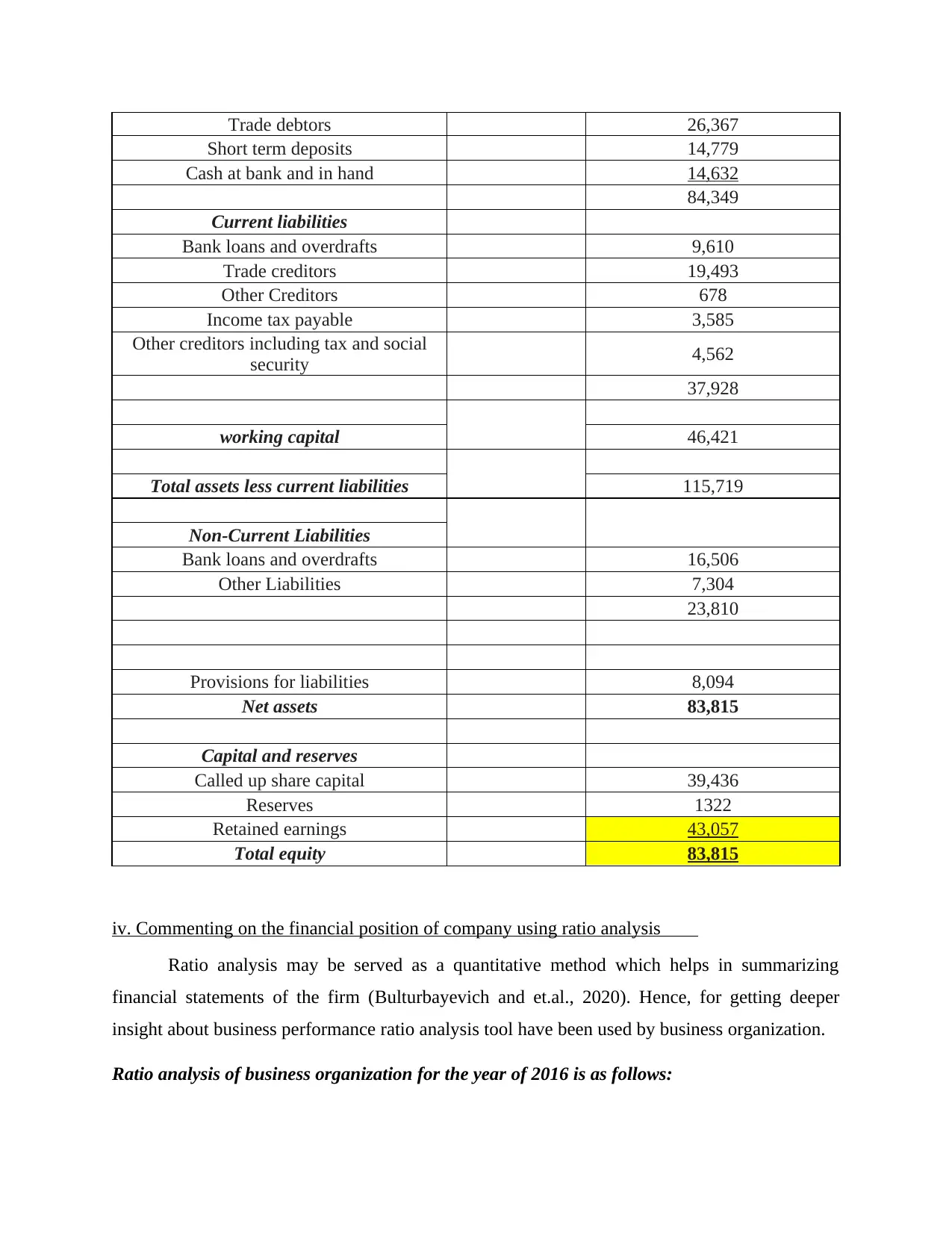
Trade debtors 26,367
Short term deposits 14,779
Cash at bank and in hand 14,632
84,349
Current liabilities
Bank loans and overdrafts 9,610
Trade creditors 19,493
Other Creditors 678
Income tax payable 3,585
Other creditors including tax and social
security 4,562
37,928
working capital 46,421
Total assets less current liabilities 115,719
Non-Current Liabilities
Bank loans and overdrafts 16,506
Other Liabilities 7,304
23,810
Provisions for liabilities 8,094
Net assets 83,815
Capital and reserves
Called up share capital 39,436
Reserves 1322
Retained earnings 43,057
Total equity 83,815
iv. Commenting on the financial position of company using ratio analysis
Ratio analysis may be served as a quantitative method which helps in summarizing
financial statements of the firm (Bulturbayevich and et.al., 2020). Hence, for getting deeper
insight about business performance ratio analysis tool have been used by business organization.
Ratio analysis of business organization for the year of 2016 is as follows:
Short term deposits 14,779
Cash at bank and in hand 14,632
84,349
Current liabilities
Bank loans and overdrafts 9,610
Trade creditors 19,493
Other Creditors 678
Income tax payable 3,585
Other creditors including tax and social
security 4,562
37,928
working capital 46,421
Total assets less current liabilities 115,719
Non-Current Liabilities
Bank loans and overdrafts 16,506
Other Liabilities 7,304
23,810
Provisions for liabilities 8,094
Net assets 83,815
Capital and reserves
Called up share capital 39,436
Reserves 1322
Retained earnings 43,057
Total equity 83,815
iv. Commenting on the financial position of company using ratio analysis
Ratio analysis may be served as a quantitative method which helps in summarizing
financial statements of the firm (Bulturbayevich and et.al., 2020). Hence, for getting deeper
insight about business performance ratio analysis tool have been used by business organization.
Ratio analysis of business organization for the year of 2016 is as follows:
Paraphrase This Document
Need a fresh take? Get an instant paraphrase of this document with our AI Paraphraser
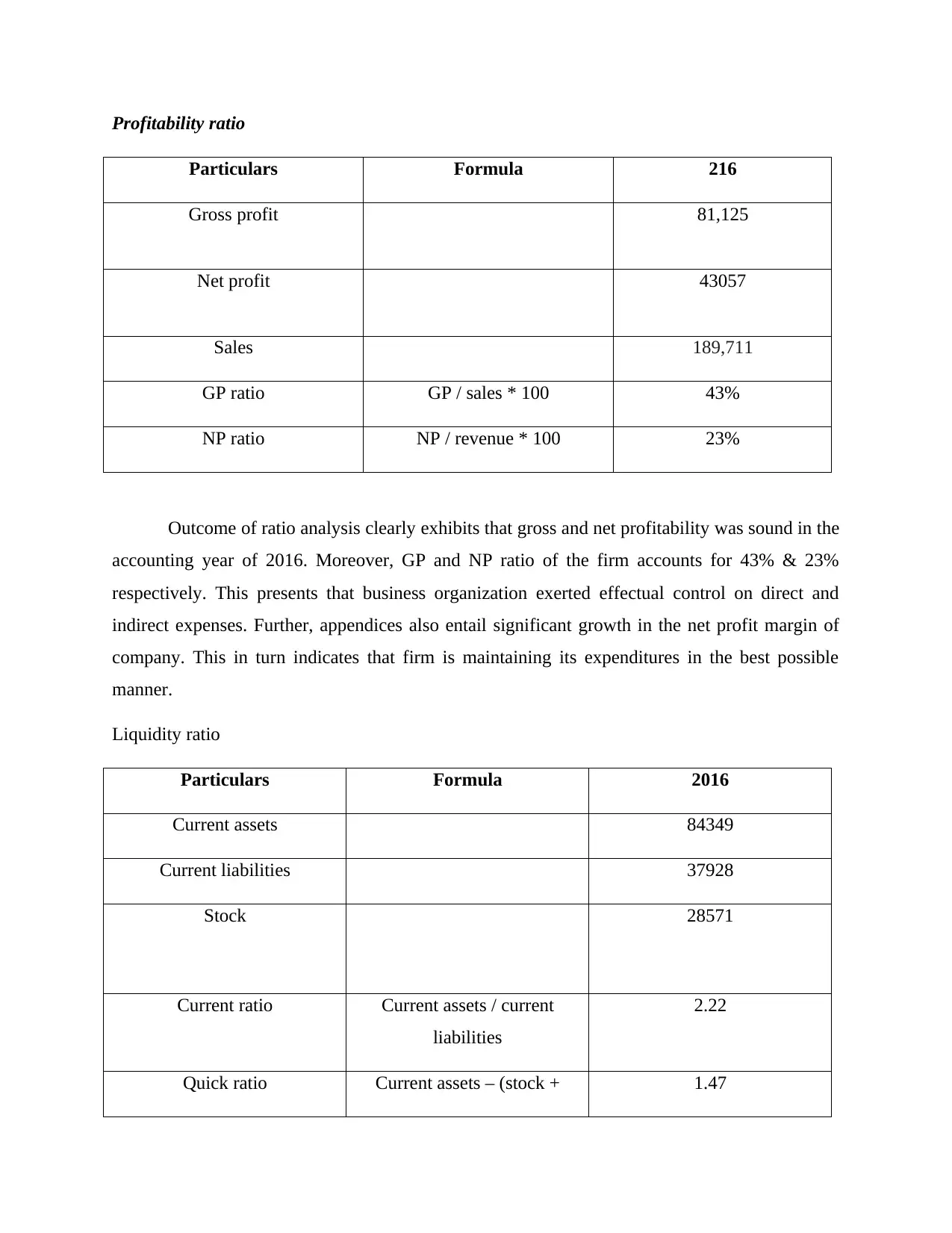
Profitability ratio
Particulars Formula 216
Gross profit 81,125
Net profit 43057
Sales 189,711
GP ratio GP / sales * 100 43%
NP ratio NP / revenue * 100 23%
Outcome of ratio analysis clearly exhibits that gross and net profitability was sound in the
accounting year of 2016. Moreover, GP and NP ratio of the firm accounts for 43% & 23%
respectively. This presents that business organization exerted effectual control on direct and
indirect expenses. Further, appendices also entail significant growth in the net profit margin of
company. This in turn indicates that firm is maintaining its expenditures in the best possible
manner.
Liquidity ratio
Particulars Formula 2016
Current assets 84349
Current liabilities 37928
Stock 28571
Current ratio Current assets / current
liabilities
2.22
Quick ratio Current assets – (stock + 1.47
Particulars Formula 216
Gross profit 81,125
Net profit 43057
Sales 189,711
GP ratio GP / sales * 100 43%
NP ratio NP / revenue * 100 23%
Outcome of ratio analysis clearly exhibits that gross and net profitability was sound in the
accounting year of 2016. Moreover, GP and NP ratio of the firm accounts for 43% & 23%
respectively. This presents that business organization exerted effectual control on direct and
indirect expenses. Further, appendices also entail significant growth in the net profit margin of
company. This in turn indicates that firm is maintaining its expenditures in the best possible
manner.
Liquidity ratio
Particulars Formula 2016
Current assets 84349
Current liabilities 37928
Stock 28571
Current ratio Current assets / current
liabilities
2.22
Quick ratio Current assets – (stock + 1.47
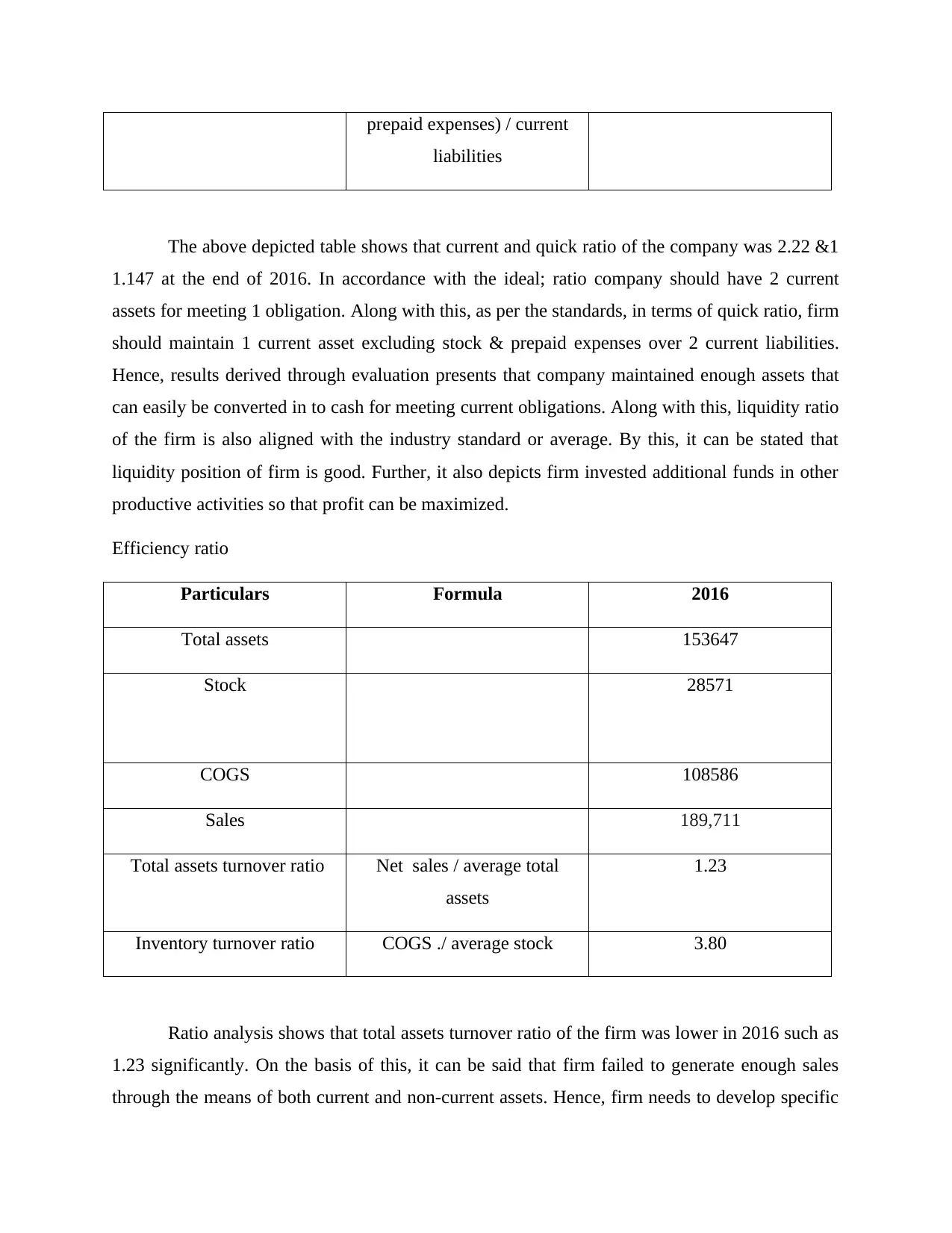
prepaid expenses) / current
liabilities
The above depicted table shows that current and quick ratio of the company was 2.22 &1
1.147 at the end of 2016. In accordance with the ideal; ratio company should have 2 current
assets for meeting 1 obligation. Along with this, as per the standards, in terms of quick ratio, firm
should maintain 1 current asset excluding stock & prepaid expenses over 2 current liabilities.
Hence, results derived through evaluation presents that company maintained enough assets that
can easily be converted in to cash for meeting current obligations. Along with this, liquidity ratio
of the firm is also aligned with the industry standard or average. By this, it can be stated that
liquidity position of firm is good. Further, it also depicts firm invested additional funds in other
productive activities so that profit can be maximized.
Efficiency ratio
Particulars Formula 2016
Total assets 153647
Stock 28571
COGS 108586
Sales 189,711
Total assets turnover ratio Net sales / average total
assets
1.23
Inventory turnover ratio COGS ./ average stock 3.80
Ratio analysis shows that total assets turnover ratio of the firm was lower in 2016 such as
1.23 significantly. On the basis of this, it can be said that firm failed to generate enough sales
through the means of both current and non-current assets. Hence, firm needs to develop specific
liabilities
The above depicted table shows that current and quick ratio of the company was 2.22 &1
1.147 at the end of 2016. In accordance with the ideal; ratio company should have 2 current
assets for meeting 1 obligation. Along with this, as per the standards, in terms of quick ratio, firm
should maintain 1 current asset excluding stock & prepaid expenses over 2 current liabilities.
Hence, results derived through evaluation presents that company maintained enough assets that
can easily be converted in to cash for meeting current obligations. Along with this, liquidity ratio
of the firm is also aligned with the industry standard or average. By this, it can be stated that
liquidity position of firm is good. Further, it also depicts firm invested additional funds in other
productive activities so that profit can be maximized.
Efficiency ratio
Particulars Formula 2016
Total assets 153647
Stock 28571
COGS 108586
Sales 189,711
Total assets turnover ratio Net sales / average total
assets
1.23
Inventory turnover ratio COGS ./ average stock 3.80
Ratio analysis shows that total assets turnover ratio of the firm was lower in 2016 such as
1.23 significantly. On the basis of this, it can be said that firm failed to generate enough sales
through the means of both current and non-current assets. Hence, firm needs to develop specific
⊘ This is a preview!⊘
Do you want full access?
Subscribe today to unlock all pages.

Trusted by 1+ million students worldwide
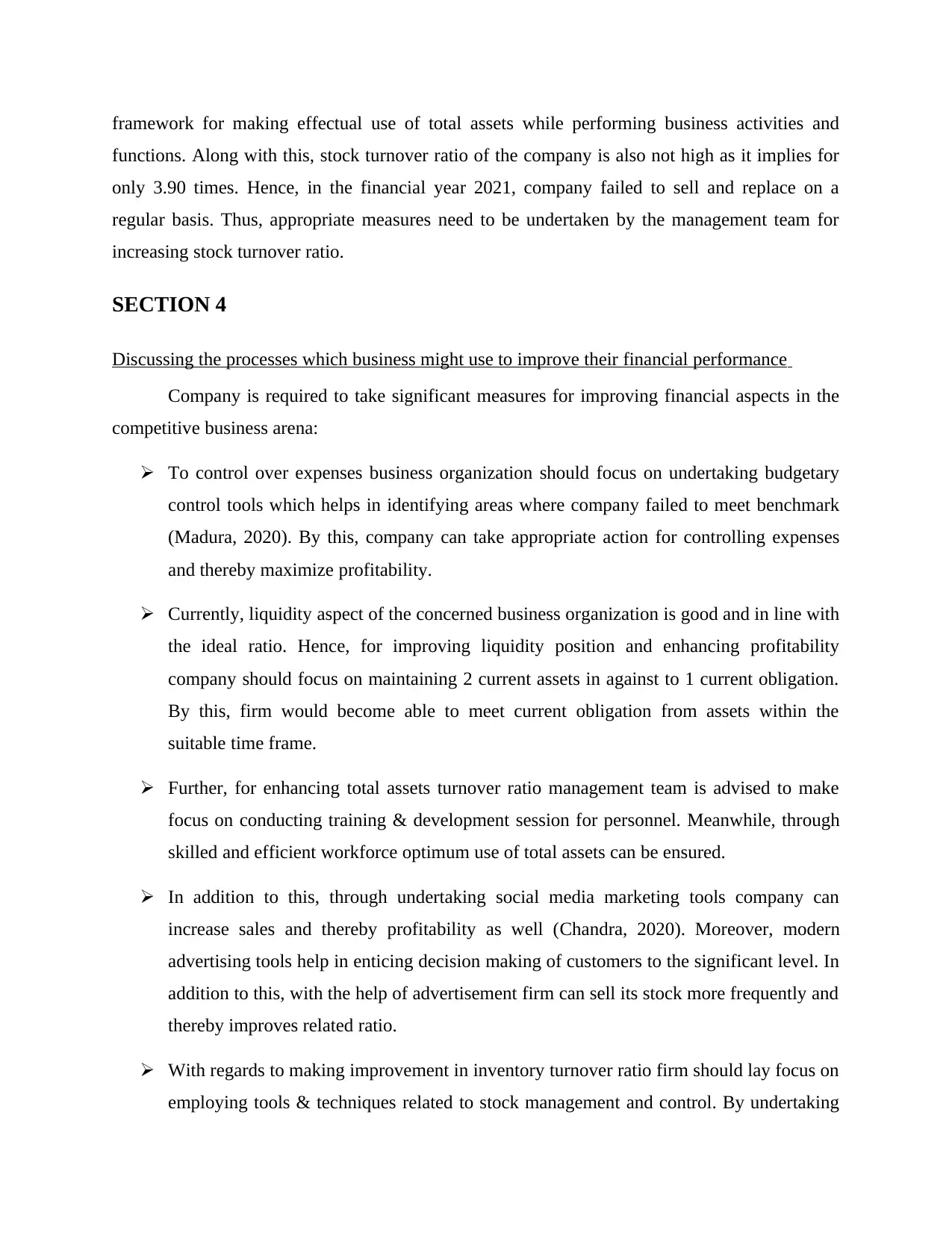
framework for making effectual use of total assets while performing business activities and
functions. Along with this, stock turnover ratio of the company is also not high as it implies for
only 3.90 times. Hence, in the financial year 2021, company failed to sell and replace on a
regular basis. Thus, appropriate measures need to be undertaken by the management team for
increasing stock turnover ratio.
SECTION 4
Discussing the processes which business might use to improve their financial performance
Company is required to take significant measures for improving financial aspects in the
competitive business arena:
To control over expenses business organization should focus on undertaking budgetary
control tools which helps in identifying areas where company failed to meet benchmark
(Madura, 2020). By this, company can take appropriate action for controlling expenses
and thereby maximize profitability.
Currently, liquidity aspect of the concerned business organization is good and in line with
the ideal ratio. Hence, for improving liquidity position and enhancing profitability
company should focus on maintaining 2 current assets in against to 1 current obligation.
By this, firm would become able to meet current obligation from assets within the
suitable time frame.
Further, for enhancing total assets turnover ratio management team is advised to make
focus on conducting training & development session for personnel. Meanwhile, through
skilled and efficient workforce optimum use of total assets can be ensured.
In addition to this, through undertaking social media marketing tools company can
increase sales and thereby profitability as well (Chandra, 2020). Moreover, modern
advertising tools help in enticing decision making of customers to the significant level. In
addition to this, with the help of advertisement firm can sell its stock more frequently and
thereby improves related ratio.
With regards to making improvement in inventory turnover ratio firm should lay focus on
employing tools & techniques related to stock management and control. By undertaking
functions. Along with this, stock turnover ratio of the company is also not high as it implies for
only 3.90 times. Hence, in the financial year 2021, company failed to sell and replace on a
regular basis. Thus, appropriate measures need to be undertaken by the management team for
increasing stock turnover ratio.
SECTION 4
Discussing the processes which business might use to improve their financial performance
Company is required to take significant measures for improving financial aspects in the
competitive business arena:
To control over expenses business organization should focus on undertaking budgetary
control tools which helps in identifying areas where company failed to meet benchmark
(Madura, 2020). By this, company can take appropriate action for controlling expenses
and thereby maximize profitability.
Currently, liquidity aspect of the concerned business organization is good and in line with
the ideal ratio. Hence, for improving liquidity position and enhancing profitability
company should focus on maintaining 2 current assets in against to 1 current obligation.
By this, firm would become able to meet current obligation from assets within the
suitable time frame.
Further, for enhancing total assets turnover ratio management team is advised to make
focus on conducting training & development session for personnel. Meanwhile, through
skilled and efficient workforce optimum use of total assets can be ensured.
In addition to this, through undertaking social media marketing tools company can
increase sales and thereby profitability as well (Chandra, 2020). Moreover, modern
advertising tools help in enticing decision making of customers to the significant level. In
addition to this, with the help of advertisement firm can sell its stock more frequently and
thereby improves related ratio.
With regards to making improvement in inventory turnover ratio firm should lay focus on
employing tools & techniques related to stock management and control. By undertaking
Paraphrase This Document
Need a fresh take? Get an instant paraphrase of this document with our AI Paraphraser
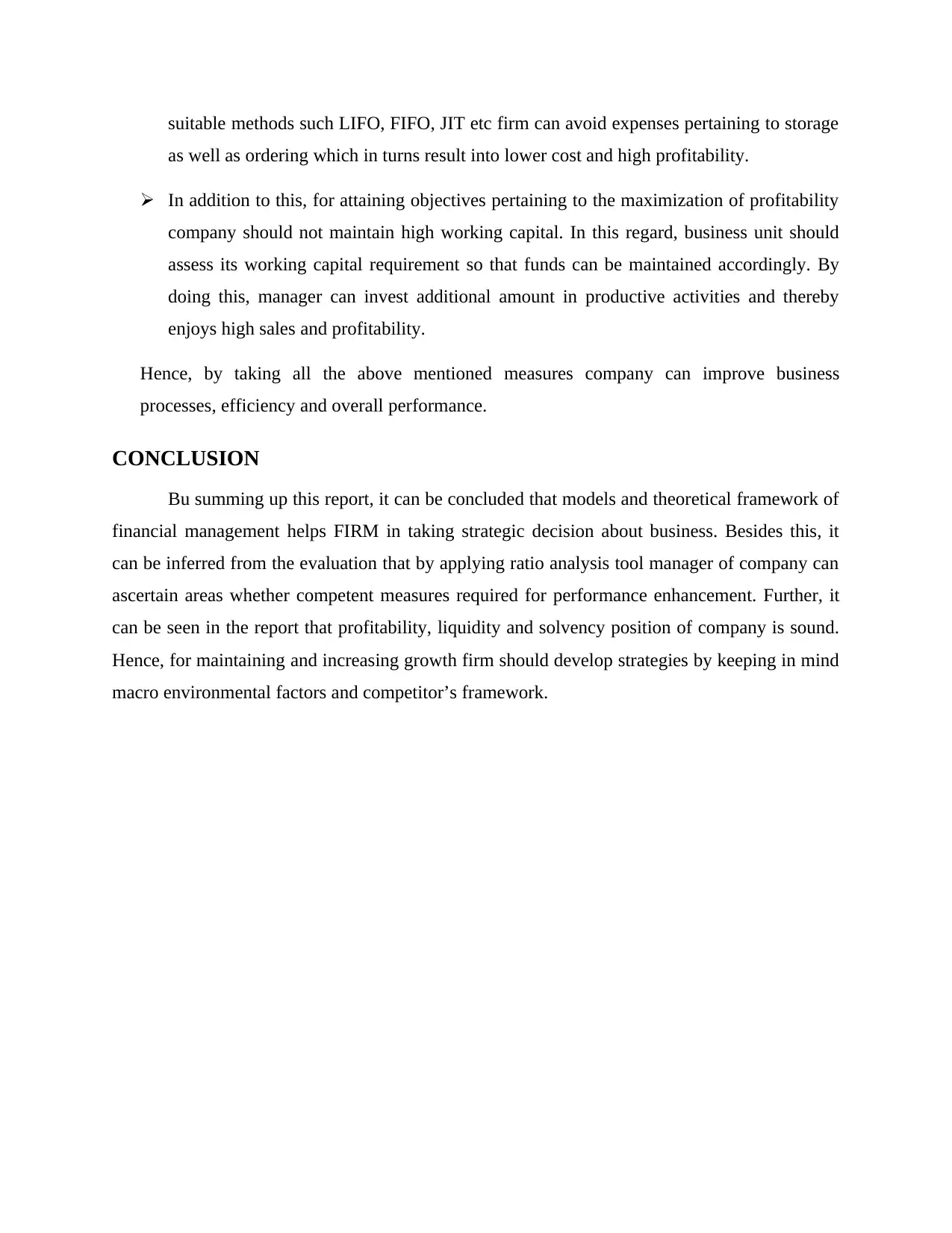
suitable methods such LIFO, FIFO, JIT etc firm can avoid expenses pertaining to storage
as well as ordering which in turns result into lower cost and high profitability.
In addition to this, for attaining objectives pertaining to the maximization of profitability
company should not maintain high working capital. In this regard, business unit should
assess its working capital requirement so that funds can be maintained accordingly. By
doing this, manager can invest additional amount in productive activities and thereby
enjoys high sales and profitability.
Hence, by taking all the above mentioned measures company can improve business
processes, efficiency and overall performance.
CONCLUSION
Bu summing up this report, it can be concluded that models and theoretical framework of
financial management helps FIRM in taking strategic decision about business. Besides this, it
can be inferred from the evaluation that by applying ratio analysis tool manager of company can
ascertain areas whether competent measures required for performance enhancement. Further, it
can be seen in the report that profitability, liquidity and solvency position of company is sound.
Hence, for maintaining and increasing growth firm should develop strategies by keeping in mind
macro environmental factors and competitor’s framework.
as well as ordering which in turns result into lower cost and high profitability.
In addition to this, for attaining objectives pertaining to the maximization of profitability
company should not maintain high working capital. In this regard, business unit should
assess its working capital requirement so that funds can be maintained accordingly. By
doing this, manager can invest additional amount in productive activities and thereby
enjoys high sales and profitability.
Hence, by taking all the above mentioned measures company can improve business
processes, efficiency and overall performance.
CONCLUSION
Bu summing up this report, it can be concluded that models and theoretical framework of
financial management helps FIRM in taking strategic decision about business. Besides this, it
can be inferred from the evaluation that by applying ratio analysis tool manager of company can
ascertain areas whether competent measures required for performance enhancement. Further, it
can be seen in the report that profitability, liquidity and solvency position of company is sound.
Hence, for maintaining and increasing growth firm should develop strategies by keeping in mind
macro environmental factors and competitor’s framework.
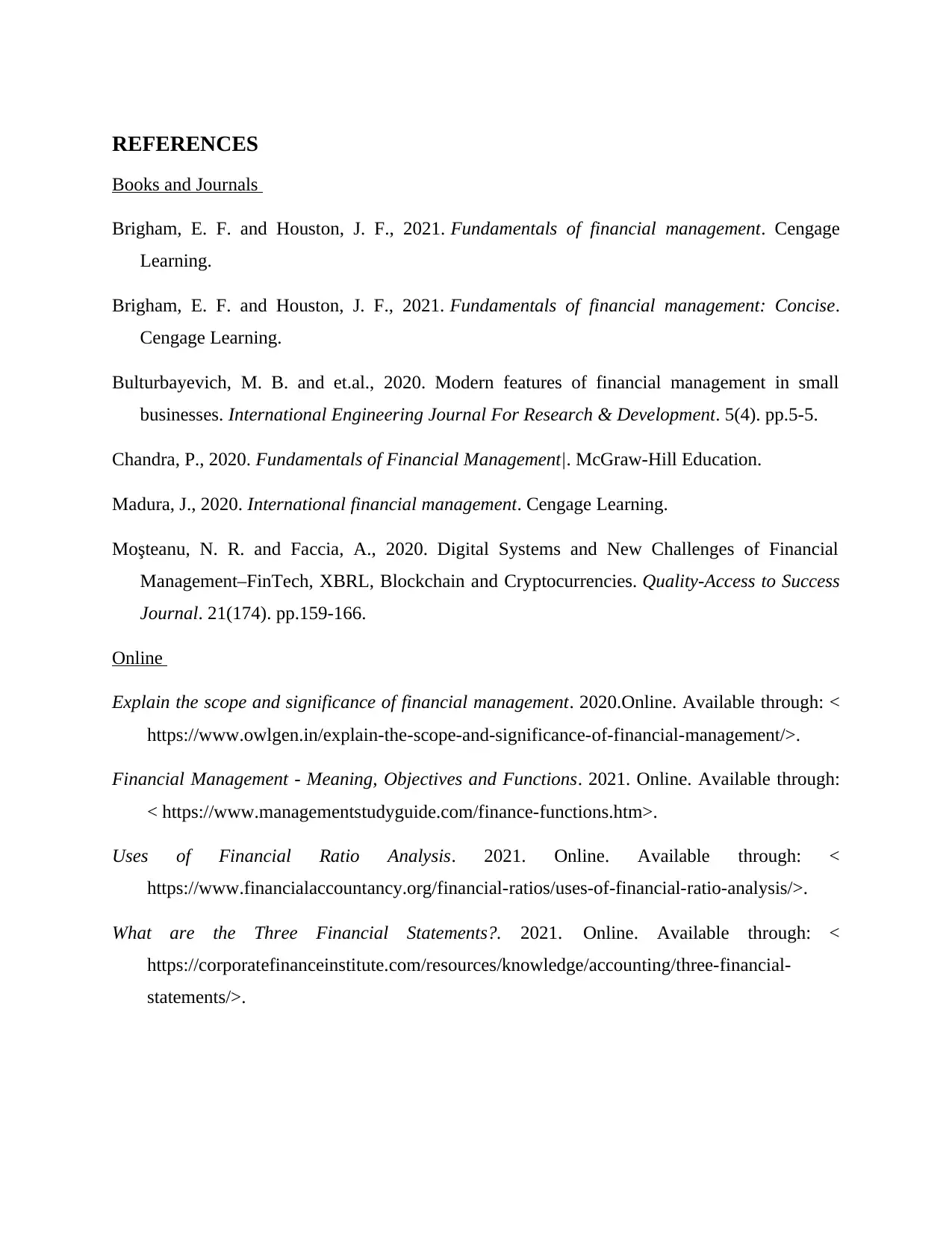
REFERENCES
Books and Journals
Brigham, E. F. and Houston, J. F., 2021. Fundamentals of financial management. Cengage
Learning.
Brigham, E. F. and Houston, J. F., 2021. Fundamentals of financial management: Concise.
Cengage Learning.
Bulturbayevich, M. B. and et.al., 2020. Modern features of financial management in small
businesses. International Engineering Journal For Research & Development. 5(4). pp.5-5.
Chandra, P., 2020. Fundamentals of Financial Management|. McGraw-Hill Education.
Madura, J., 2020. International financial management. Cengage Learning.
Moşteanu, N. R. and Faccia, A., 2020. Digital Systems and New Challenges of Financial
Management–FinTech, XBRL, Blockchain and Cryptocurrencies. Quality-Access to Success
Journal. 21(174). pp.159-166.
Online
Explain the scope and significance of financial management. 2020.Online. Available through: <
https://www.owlgen.in/explain-the-scope-and-significance-of-financial-management/>.
Financial Management - Meaning, Objectives and Functions. 2021. Online. Available through:
< https://www.managementstudyguide.com/finance-functions.htm>.
Uses of Financial Ratio Analysis. 2021. Online. Available through: <
https://www.financialaccountancy.org/financial-ratios/uses-of-financial-ratio-analysis/>.
What are the Three Financial Statements?. 2021. Online. Available through: <
https://corporatefinanceinstitute.com/resources/knowledge/accounting/three-financial-
statements/>.
Books and Journals
Brigham, E. F. and Houston, J. F., 2021. Fundamentals of financial management. Cengage
Learning.
Brigham, E. F. and Houston, J. F., 2021. Fundamentals of financial management: Concise.
Cengage Learning.
Bulturbayevich, M. B. and et.al., 2020. Modern features of financial management in small
businesses. International Engineering Journal For Research & Development. 5(4). pp.5-5.
Chandra, P., 2020. Fundamentals of Financial Management|. McGraw-Hill Education.
Madura, J., 2020. International financial management. Cengage Learning.
Moşteanu, N. R. and Faccia, A., 2020. Digital Systems and New Challenges of Financial
Management–FinTech, XBRL, Blockchain and Cryptocurrencies. Quality-Access to Success
Journal. 21(174). pp.159-166.
Online
Explain the scope and significance of financial management. 2020.Online. Available through: <
https://www.owlgen.in/explain-the-scope-and-significance-of-financial-management/>.
Financial Management - Meaning, Objectives and Functions. 2021. Online. Available through:
< https://www.managementstudyguide.com/finance-functions.htm>.
Uses of Financial Ratio Analysis. 2021. Online. Available through: <
https://www.financialaccountancy.org/financial-ratios/uses-of-financial-ratio-analysis/>.
What are the Three Financial Statements?. 2021. Online. Available through: <
https://corporatefinanceinstitute.com/resources/knowledge/accounting/three-financial-
statements/>.
⊘ This is a preview!⊘
Do you want full access?
Subscribe today to unlock all pages.

Trusted by 1+ million students worldwide
1 out of 13
Related Documents
Your All-in-One AI-Powered Toolkit for Academic Success.
+13062052269
info@desklib.com
Available 24*7 on WhatsApp / Email
![[object Object]](/_next/static/media/star-bottom.7253800d.svg)
Unlock your academic potential
Copyright © 2020–2025 A2Z Services. All Rights Reserved. Developed and managed by ZUCOL.


